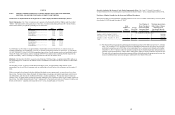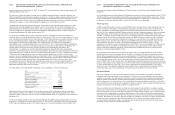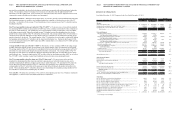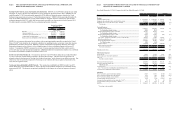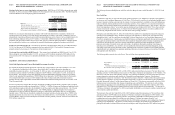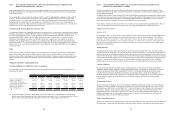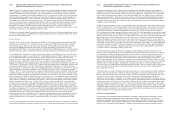Dish Network 2012 Annual Report Download - page 37
Download and view the complete annual report
Please find page 37 of the 2012 Dish Network annual report below. You can navigate through the pages in the report by either clicking on the pages listed below, or by using the keyword search tool below to find specific information within the annual report.Item 7. MANAGEMENT’S DISCUSSION AND ANALYSIS OF FINANCIAL CONDITION AND
RESULTS OF OPERATIONS - Continued
62
62
EXPLANATION OF KEY METRICS AND OTHER ITEMS
Subscriber-related revenue. “Subscriber-related revenue” consists principally of revenue from basic, premium
movie, local, HD programming, pay-per-view, Latino and international subscription television services, broadband
services, equipment rental fees and other hardware related fees, including fees for DVRs, fees for broadband
equipment, equipment upgrade fees and additional outlet fees from subscribers with receivers with multiple tuners,
advertising services, fees earned from our in-home service operations and other subscriber revenue. Certain of the
amounts included in “Subscriber-related revenue” are not recurring on a monthly basis.
Equipment and merchandise sales, rental and other revenue. “Equipment and merchandise sales, rental and other
revenue” principally includes the non-subsidized sales of DBS accessories to retailers and other third-party distributors
of our equipment domestically and to Pay-TV subscribers. Effective April 26, 2011, revenue from merchandise sold to
customers including movies, video games and other items, and revenue from the rental of movies and video games
and the sale of previously rented titles related to our Blockbuster operations are included in this category.
Equipment sales, services and other revenue – EchoStar. “Equipment sales, services and other revenue –
EchoStar” includes revenue related to equipment sales, services, and other agreements with EchoStar.
Subscriber-related expenses. “Subscriber-related expenses” principally include programming expenses, which
represent a substantial majority of these expenses. “Subscriber-related expenses” also include costs for pay-TV and
broadband services incurred in connection with our in-home service and call center operations, billing costs,
refurbishment and repair costs related to receiver systems, subscriber retention, other variable subscriber expenses
and monthly wholesale fees paid to broadband providers. Prior to the fourth quarter 2012, certain costs related to
the acquisition of new broadband subscribers were included in this category. Beginning in the fourth quarter 2012,
our “Subscriber-related expenses” exclude these costs related to the acquisition of new broadband subscribers.
During the fourth quarter 2012, expenses related to the acquisition of new broadband subscribers for the period
beginning January 1, 2012 through September 30, 2012 that were previously included in “Subscriber-related
expenses” were reclassified to “Subscriber acquisition costs.” These amounts associated with the acquisition of new
broadband subscribers for prior years were immaterial.
Satellite and transmission expenses – EchoStar. “Satellite and transmission expenses – EchoStar” includes the cost
of leasing satellite and transponder capacity from EchoStar and the cost of digital broadcast operations provided to us
by EchoStar, including satellite uplinking/downlinking, signal processing, conditional access management, telemetry,
tracking and control, and other professional services.
Satellite and transmission expenses – other. “Satellite and transmission expenses – other” includes executory costs
associated with capital leases and costs associated with transponder leases and other related services. Effective
March 9, 2012, expenses related to our wireless spectrum segment are included in this category.
Cost of sales - equipment, merchandise, services, rental and other. “Cost of sales - equipment, merchandise,
services, rental and other” principally includes the cost of non-subsidized sales of DBS accessories to retailers and
other third-party distributors of our equipment domestically and to Pay-TV subscribers. Effective April 26, 2011, the
cost of movies and video games including rental title purchases or revenue sharing to studios, packaging and online
delivery costs and cost of merchandise sold including movies, video games and other items related to our
Blockbuster operations are included in this category. In addition, “Cost of sales - equipment, merchandise, services,
rental and other” includes costs related to equipment sales, services, and other agreements with EchoStar.
Subscriber acquisition costs. In addition to leasing receivers, we generally subsidize installation and all or a portion
of the cost of our receiver systems to attract new Pay-TV subscribers. Our “Subscriber acquisition costs” include the
cost of subsidized sales of receiver systems to retailers and other third-party distributors of our equipment, the cost of
subsidized sales of receiver systems directly by us to subscribers, including net costs related to our promotional
incentives, costs related to our direct sales efforts and costs related to installation and acquisition advertising. In
addition, beginning in the fourth quarter 2012, our “Subscriber acquisition costs” include the cost of sales, direct sales
efforts and costs related to installations associated with our broadband services. During the fourth quarter 2012,
certain expenses related to our broadband services for the period beginning January 1, 2012 through September 30,
Item 7. MANAGEMENT’S DISCUSSION AND ANALYSIS OF FINANCIAL CONDITION AND
RESULTS OF OPERATIONS - Continued
63
63
2012 that were previously included in “Subscriber-related expenses” were reclassified to “Subscriber acquisition
costs.” These amounts associated with our broadband services for 2011 were immaterial. We exclude the value of
equipment capitalized under our lease program for new Pay-TV and broadband subscribers from “Subscriber
acquisition costs.”
Pay-TV SAC. Subscriber acquisition cost measures are commonly used by those evaluating companies in the Pay-
TV industry. We are not aware of any uniform standards for calculating the “average subscriber acquisition costs
per new Pay-TV subscriber activation,” or Pay-TV SAC, and we believe presentations of Pay-TV SAC may not be
calculated consistently by different companies in the same or similar businesses. Our Pay-TV SAC is calculated as
“Subscriber acquisition costs,” excluding “Subscriber acquisition costs” associated with our broadband services, plus
the value of equipment capitalized under our lease program for new Pay-TV subscribers, divided by gross new Pay-
TV subscriber activations. We include all the costs of acquiring Pay-TV subscribers (e.g., subsidized and
capitalized equipment) as we believe it is a more comprehensive measure of how much we are spending to acquire
subscribers. We also include all new Pay-TV subscribers in our calculation, including Pay-TV subscribers added
with little or no subscriber acquisition costs. During the fourth quarter 2012, we have elected to provide Pay-TV
SAC rather than SAC, defined below, as we believe Pay-TV SAC provides a more meaningful metric.
SAC. Historically, we have calculated SAC as “Subscriber acquisition costs,” plus the value of equipment
capitalized under our lease program for new subscribers, divided by gross new subscriber activations. This metric
included the cost (e.g., subsidized and capitalized equipment) of acquiring Pay-TV subscribers and certain costs of
acquiring broadband subscribers. We also included all new Pay-TV subscribers in our calculation, including Pay-
TV subscribers added with little or no subscriber acquisition costs. During the fourth quarter 2012, we have elected
to discontinue providing SAC as we believe Pay-TV SAC, which excludes broadband subscriber acquisition costs,
provides a more meaningful metric.
General and administrative expenses. “General and administrative expenses” consists primarily of employee-
related costs associated with administrative services such as legal, information systems, accounting and finance,
including non-cash, stock-based compensation expense. It also includes outside professional fees (e.g., legal,
information systems and accounting services) and other items associated with facilities and administration.
Litigation expense. “Litigation expense” primarily consists of legal settlements, judgments or accruals associated with
certain significant litigation.
Interest expense, net of amounts capitalized. “Interest expense, net of amounts capitalized” primarily includes
interest expense, prepayment premiums and amortization of debt issuance costs associated with our senior debt (net
of capitalized interest), and interest expense associated with our capital lease obligations.
Other, net. The main components of “Other, net” are gains and losses realized on the sale and/or conversion of
investments, impairment of marketable and non-marketable investment securities, unrealized gains and losses from
changes in fair value of marketable and non-marketable strategic investments accounted for at fair value, and equity
in earnings and losses of our affiliates.
Earnings before interest, taxes, depreciation and amortization (“EBITDA”). EBITDA is defined as “Net income
(loss) attributable to DISH Network” plus “Interest expense, net of amounts capitalized” net of “Interest income,”
“Income tax (provision) benefit, net” and “Depreciation and amortization.” This “non-GAAP measure” is reconciled
to “Net income (loss) attributable to DISH Network” in our discussion of “Results of Operations” below.
“Pay-TV subscribers.” We include customers obtained through direct sales, third-party retailers and other third-
party distribution relationships in our Pay-TV subscriber count. We also provide pay-TV service to hotels, motels
and other commercial accounts. For certain of these commercial accounts, we divide our total revenue for these
commercial accounts by an amount approximately equal to the retail price of our DISH America programming
package, and include the resulting number, which is substantially smaller than the actual number of commercial
units served, in our Pay-TV subscriber count. Effective during the first quarter 2011, we made two changes to this
calculation methodology compared to prior periods. Beginning February 1, 2011, the retail price of our DISH
America programming package was used in the calculation rather than America’s Top 120 programming package,
which had been used in prior periods. We also determined that two of our commercial business lines, which had







